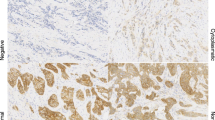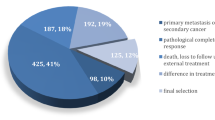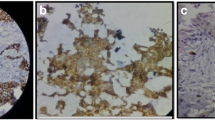Summary
Upregulation of N-cadherin in epithelial tumor cells has been shown to contribute to the invasive/metastatic phenotype. It remains however to be determined whether N-cadherin is increased in human breast cancers with enhanced malignant potential. We examined a large number of invasive breast cancer specimens (n=114) for N- and E-cadherin. These specimens compared invasive duct carcinomas (IDCs) of varying histologic grades with an aggressive subtype, invasive micropapillary carcinoma of the breast (MPAP), which has a high propensity for lymphatic invasion and lymph node metastasis. Staining scores for N- and E-cadherin were compared between non-MPAP and MPAP IDCs, and between the invasive and ductal carcinoma in situ (DCIS) of each IDC using statistical analysis. We found that N-cadherin was expressed in 76% of MPAP and 52% of non-MPAP carcinomas, and E-cadherin in 57% of MPAP and 36% of non-MPAP tumors. More MPAP (25%) compared to non-MPAP (5%) tumors expressed both cadherins. Of the two cadherins, N-cadherin was significantly associated with MPAP tumors (p=0.033) compared to E-cad (p=0.171). Moreover, in the majority of tumors that were positive for N-cadherin, the staining scores were increased in the IDC relative to intraductal components, and this effect was more dramatic in the MPAP carcinomas. This difference for N-cadherin was greater than the corresponding difference for E-cadherin in the MPAP group (p=0.005), whereas such changes were not significant in the non-MPAP group (p=0.10). Thus, N-cadherin is associated with tumor aggressiveness and metastatic potential and may contribute to tumor progression.
Similar content being viewed by others
References
C Blood and B Zetter, Tumor interactions with the vasculature: angiogenesis and metastasis. Biochem Biophys Acta 1032 (1990) 89-118
LA Liotta, PS Steeg and WG Stetler-Stevenson, Cancer metastasis and angiogenesis: an imbalance of positive and negative regulation. Cell 64 (1991) 327-336
M Bracke, FV Roy and M Mareel, The E-cadherin/catenin complex in invasion and metastasis. In: U Gunthert and W Birchmeier (eds.) Attempts to Understand Metastasis Formation I Metastasis- related molecules. Berlin: Springer (1996) pp. 123-161
W Birchmeier, J Behrens, KM Weidner, J Hulsken and C Birchmeier, Epithelial differentiation and the control of metastasis in carcinomas. Curr Top Microbiol Immunol 213 (1996) 117-135
M Takeichi, Cadherins in cancer: implications for invasion and metastasis. Curr Opin Cell Biol 5 (1993) 806-811
R Kemler, Classical cadherins. Semin Cell Biol 3 (1992) 149-155
M Takeichi, Cadherins: a molecular family important in selective cell–cell adhesion. Annu Rev Biochem 59 (1990) 237-252
K Hatta, S Takagi, H Fujisawa and M Takeichi, Spatial and temporal expression pattern of N-cadherin cell adhesion molecules correlated with morphogenetic processes of chicken embryos. Dev Biol 120 (1987) 215-227
K Hatta and M Takeichi, Expression of N-cadherin adhesion molecules associated with early morphogenetic events in chick development. Nature 320 (1986) 447-449
C Redies and M Takeichi, Expression of N-cadherin mRNA during development of the mouse brain. Dev Dyn 197 (1993) 26-39
JL Bixby and R Zhang, Purified N-cadherin is a potent substrate for the rapid induction of neurite outgrowth. J Cell Biol 110 (1990) 1253-1260
BM Gumbiner, Proteins associated with the cytoplasmic surface of adhesion molecules. Neuron 11 (1993) 551-564
M Ozawa, M Ringwald and R Kemler, Uvomorulin-catenin complex formation is regulated by a specific domain in the cytoplasmic region of the cell adhesion molecule. Proc Natl Acad Sci USA 87 (1990) 4246-4250
M Wheelock, K Knudsen and K Johnson, Membrane-cytoskeleton interactions with cadherin cell adhesion proteins: role of catenins as linker proteins. Curr Top Membr 43 (1996) 169-185
RB Hazan, L Kang, BP Whooley and PI Borgen, N-cadherin promotes adhesion between invasive breast cancer cells and the stroma. Cell Adhes Commun 4 (1997) 399-411
S Islam, TE Carey, GT Wolf, MJ Wheelock and KR Johnson, Expression of N-cadherin by human squamous carcinoma cells induces a scattered fibroblastic phenotype with disrupted cell–cell adhesion. J Cell Biol 135 (1996) 1643-1654
MT Nieman, RS Prudoff, KR Johnson and MJ Wheelock, N-cadherin promotes motility in human breast cancer cells regardless of their E-cadherin expression. J Cell Biol 147 (1999) 631-644
RB Hazan, GR Phillips, RF Qiao, L Norton and SA Aaronson, Exogenous expression of N-cadherin in breast cancer cells induces cell migration, invasion, and metastasis. J Cell Biol 148 (2000) 779-790
K Suyama, I Shapiro, M Guttman and RB Hazan, A signaling pathway leading to metastasis is controlled by N-cadherin and the FGF receptor. Cancer Cell 2 (2002) 301-314
MM Walsh and IJ Bleiweiss, Invasive micropapillary carcinoma of the breast: eighty cases of an underrecognized entity. Hum Pathol 32 (2001) 583-589
S Siriaunkgul and FA Tavassoli, Invasive micropapillary carcinoma of the breast. Mod Pathol 6 (1993) 660-662
S Luna-More, B Gonzalez, C Acedo, I Rodrigo and C Luna, Invasive micropapillary carcinoma of the breast. A new special type of invasive mammary carcinoma. Pathol Res Pract 190 (1994) 668-674
O Zekioglu, Y Erhan, M Ciris, H Bayramoglu and N Ozdemir, Invasive micropapillary carcinoma of the breast: high incidence of lymph node metastasis with extranodal extension and its immunohistochemical profile compared with invasive ductal carcinoma. Histopathology 44 (2004) 18-23
H Tanaka, W Shan, GR Phillips, K Arndt, O Bozdagi, L Shapiro, GW Huntley, DL Benson and DR Colman, Molecular modification of N-cadherin in response to synaptic activity. Neuron 25 (2000) 93-107
CL Sommers, EW Thompson, JA Torri, R Kemler, EP Gelmann and SW Byers, Cell adhesion molecule uvomorulin expression in human breast cancer cell lines: relationship to morphology and invasive capacities. Cell Growth Differ 2 (1991) 365-372
DC Allred, JM Harvey, M Berardo and GM Clark, Prognostic and predictive factors in breast cancer by immunohistochemical analysis. Mod Pathol 11 (1998) 155-168
J Cohen, Statistical power analysis for the behavioral sciences, Revised edn. New York: Academic Press (1977).
H Oka, H Shiozaki, K Kobayashi, M Inoue, H Tahara, T Kobayashi, Y Takatsuka, N Matsuyoshi, S Hirano and M Takeichi, Expression of E-cadherin cell adhesion molecules in human breast cancer tissues and its relationship to metastasis. Cancer Res 53 (1993) 1696-1701
NL Tran, RB Nagle, AE Cress and RL Heimark, N-Cadherin expression in human prostate carcinoma cell lines. An epithelial-mesenchymal transformation mediating adhesion withStromal cells. Am J Pathol 155 (1999) 787-798
E Rosivatz, I Becker, M Bamba, C Schott, J Diebold, D Mayr, H Hofler and KF Becker, Neoexpression of N-cadherin in E-cadherin positive colon cancers. Int J Cancer 111 (2004) 711-719
S Nakajima, R Doi, E Toyoda, S Tsuji, M Wada, M Koizumi, SS Tulachan, D Ito, K Kami and T Mori, N-cadherin expression and epithelial-mesenchymal transition in pancreatic carcinoma. Clin Cancer Res 10 (2004) 4125-4133
G Li, K Satyamoorthy and M Herlyn, Dynamics of cell interactions and communications during melanoma development. Crit Rev Oral Biol Med 13 (2002) 62-70
P Debruyne, S Vermeulen and M Mareel, The role of the E-cadherin/catenin complex in gastrointestinal cancer. Acta Gastroenterol Belg 62 (1999) 393-402
F Graziano, B Humar and P Guilford, The role of the E-cadherin gene (CDH1) in diffuse gastric cancer susceptibility: from the laboratory to clinical practice. Ann Oncol 14 (2003) 1705-1713
K Yoshinaga, H Inoue, T Utsunomiya, H Sonoda, T Masuda, K Mimori, Y Tanaka and M Mori, N-cadherin is regulated by activin A and associated with tumor aggressiveness in esophageal carcinoma. Clin Cancer Res 10 (2004) 5702-5707
K Tomita, A Bokhoven van, GJ Leenders van, ET Ruijter, CF Jansen, MJ Bussemakers and JA Schalken, Cadherin switching in human prostate cancer progression. Cancer Res 60 (2000) 3650-3654
JP Thiery, Epithelial-mesenchymal transitions in tumour progression. Nat Rev Cancer 2 (2002) 442-454
D Blanco, S Vicent, E Elizegi, I Pino, MF Fraga, M Esteller, U Saffiotti, F Lecanda and LM Montuenga, Altered expression of adhesion molecules and epithelial-mesenchymal transition in silica-induced rat lung carcinogenesis. Lab Invest 84 (2004) 999-1012
J Behrens, L Vakaet, R Friis, E Winterhager, F Roy Van, MM Mareel and W Birchmeier, Loss of epithelial differentiation and gain of invasiveness correlates with tyrosine phosphorylation of the E-cadherin/beta-catenin complex in cells transformed with a temperature-sensitive v-SRC gene. J Cell Biol 120 (1993) 757-766
PM Siegel, W Shu, RD Cardiff, WJ Muller and J Massague, Transforming growth factor beta signaling impairs Neu-induced mammary tumorigenesis while promoting pulmonary metastasis. Proc Natl Acad Sci USA 100 (2003) 8430-8435
Y Kang, PM Siegel, W Shu, M Drobnjak, SM Kakonen, C Cordon-Cardo, TA Guise and J Massague, A multigenic program mediating breast cancer metastasis to bone. Cancer Cell 3 (2003) 537-549
NA Bhowmick, M Ghiassi, A Bakin, M Aakre, CA Lundquist, ME Engel, CL Arteaga and HL Moses, Transforming growth factor-beta1 mediates epithelial to mesenchymal transdifferentiation through a RhoA-dependent mechanism. Mol Biol Cell 12 (2001) 27-36
HJ Burstein, K Polyak, JS Wong, SC Lester and CM Kaelin, Ductal carcinoma in situ of the breast. N Engl J Med 350 (2004) 1430-1441
G Berx, AM Cleton-Jansen, K Strumane, WJ Leeuw de, F Nollet, F Roy van and C Cornelisse, E-cadherin is inactivated in a majority of invasive human lobular breast cancers by truncation mutations throughout its extracellular domain. Oncogene 13 (1996) 1919-1925
NS Goldstein, LL Kestin and FA Vicini, Clinicopathologic implications of E-cadherin reactivity in patients with lobular carcinoma in situ of the breast. Cancer 92 (2001) 738-747
NS Goldstein, Does the level of E-cadherin expression correlate with the primary breast carcinoma infiltration pattern and type of systemic metastases?. Am J Clin Pathol 118 (2002) 425-434
A Kovacs, J Dhillon and RA Walker, Expression of P-cadherin, but not E-cadherin or N-cadherin, relates to pathological and functional differentiation of breast carcinomas. Mol Pathol 56 (2003) 318-322
Author information
Authors and Affiliations
Corresponding author
Rights and permissions
About this article
Cite this article
Nagi, C., Guttman, M., Jaffer, S. et al. N-cadherin Expression in Breast Cancer: Correlation with an Aggressive Histologic Variant – Invasive Micropapillary Carcinoma. Breast Cancer Res Treat 94, 225–235 (2005). https://doi.org/10.1007/s10549-005-7727-5
Published:
Issue Date:
DOI: https://doi.org/10.1007/s10549-005-7727-5




